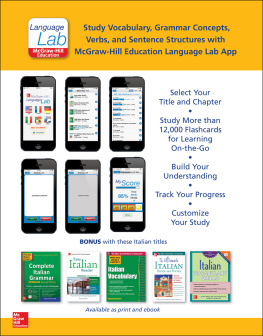PRACTICE MAKES PERFECT
Italian Sentence Builder
PRACTICE MAKES PERFECT
Italian Sentence Builder
Paola Nanni-Tate

Copyright 2010 by The McGraw-Hill Companies, Inc. All rights reserved. Except as permitted under the United States Copyright Act of 1976, no part of this publication may be reproduced or distributed in any form or by any means, or stored in a database or retrieval system, without the prior written permission of the publisher. ISBN: 978-0-07-160036-1 MHID: 0-07-160036-1 The material in this eBook also appears in the print version of this title: ISBN: 978-0-07-160035-4, MHID: 0-07-160035-3 All trademarks are trademarks of their respective owners. Rather than put a trademark symbol after every occurrence of a trademarked name, we use names in an editorial fashion only, and to the benefit of the trademark owner, with no intention of infringement of the trademark. Where such designations appear in this book, they have been printed with initial caps McGraw-Hill eBooks are available at special quantity discounts to use as premiums and sales promotions, or for use in corporate training programs.
To contact a representative please e-mail us at bulksales@mcgraw-hill.com. TERMS OF USE This is a copyrighted work and The McGraw-Hill Companies, Inc. ("McGraw-Hill") and its licensors reserve all rights in and to the work. Use of this work is subject to these terms. Except as permitted under the Copyright Act of 1976 and the right to store and retrieve one copy of the work, you may not decompile, disassemble, reverse engineer, reproduce, modify, create derivative works based upon, transmit, distribute, disseminate, sell, publish or sublicense the work or any part of it without McGraw-Hill's prior consent. You may use the work for your own noncommercial and personal use; any other use of the work is strictly prohibited.
Your right to use the work may be terminated if you fail to comply with these terms. THE WORK IS PROVIDED "AS IS." McGRAW-HILL AND ITS LICENSORS MAKE NO GUARANTEES OR WARRANTIES AS TO THE ACCURACY, ADEQUACY OR COMPLETENESS OF OR RESULTS TO BE OBTAINED FROM USING THE WORK, INCLUDING ANY INFORMATION THAT CAN BE ACCESSED THROUGH THE WORK VIA HYPERLINK OR OTHERWISE, AND EXPRESSLY DISCLAIM ANY WARRANTY, EXPRESS OR IMPLIED, INCLUDING BUT NOT LIMITED TO IMPLIED WARRANTIES OF MERCHANTABILITY OR FITNESS FOR A PARTICULAR PURPOSE. McGraw-Hill and its licensors do not warrant or guarantee that the functions contained in the work will meet your requirements or that its operation will be uninterrupted or error free. Neither McGraw-Hill nor its licensors shall be liable to you or anyone else for any inaccuracy, error or omission, regardless of cause, in the work or for any damages resulting therefrom. McGraw-Hill has no responsibility for the content of any information accessed through the work. Under no circumstances shall McGraw-Hill and/or its licensors be liable for any indirect, incidental, special, punitive, consequential or similar damages that result from the use of or inability to use the work, even if any of them has been advised of the possibility of such damages.
This limitation of liability shall apply to any claim or cause whatsoever whether such claim or cause arises in contract, tort or otherwise.
Contents
Introduction
Writing skills can be difficult to acquire and use effectively in any language. This is particularly true when writing in a foreign language. This book will guide you through the many different structures in the Italian language and show you how to avoid the common pitfalls of writing in a foreign language. In order to learn to write well, you need considerable practice. This book provides many exercises in which you will put to use the rules that are explained in each chapter.
At the end of the book you will also have plenty of opportunities to be creative and come up with your own original sentences. In addition, an answer key is provided at the back of the book. It includes the answers for the exercises, as well as sample answers for the more creative exercises, to ensure that you are on the right track. Good sentence writing can be a difficult, but not impossible, task. It requires breaking the habit of translating word for word from your mother tongue and, instead, acquiring a feeling for the particulars of the new language. It is my wish that this book be your guide to writing with confidence in Italian.
Remember that learning a foreign language takes time. Dont be too hard on yourself, and be patient. In bocca al lupo! (Good luck!) PRACTICE MAKES PERFECT
Italian Sentence Builder
1 Declarative sentences and word order
Phrases and sentences are different in nature and serve different purposes. A phrase is made up of more than one word but does not have a
subject +
predicate structure. one or more words phrase subject + predicate sentence Phrases are used frequently in colloquial Italian and daily conversations.

Below are examples of proverbs or short sayings commonly used in the Italian language.
They are phrases because they do not have a subject-verb structure.  A sentence is an organized idea or thought. It is a grammatical unit consisting of different elements such as nouns, verbal structures, adverbs, modifiers, and object pronouns. Each element contributes to a sentences structure. A sentence expresses a statement, a question, a command, a wish, or an exclamation. In writing, it generally begins with a capital letter and ends with the appropriate punctuation.
A sentence is an organized idea or thought. It is a grammatical unit consisting of different elements such as nouns, verbal structures, adverbs, modifiers, and object pronouns. Each element contributes to a sentences structure. A sentence expresses a statement, a question, a command, a wish, or an exclamation. In writing, it generally begins with a capital letter and ends with the appropriate punctuation.
In speaking, it is expressed with various stresses, pitches, and pauses. Following is an example of a simple sentence:  This sentence consists of a subject (Maria) and a predicate (parla litaliano, including the verb parla). The subject, the who or what the sentence is about, is often the first element in a sentence. The predicate expresses the action of the subject.
This sentence consists of a subject (Maria) and a predicate (parla litaliano, including the verb parla). The subject, the who or what the sentence is about, is often the first element in a sentence. The predicate expresses the action of the subject.
Declarative sentences
Depending on the action they perform, sentences are classified into categories. First we will examine the declarative sentence.
Declarative sentences are simple sentences with one verb in the indicative tense. They state a fact, an idea, or an argument. Declarative sentences make a statement and communicate information; they do not ask questions, express exclamations, or give commands. These sentences use the following elements:  Take a look at the following sentences:
Take a look at the following sentences:  The verbs in these declarative sentences are in the indicative mode of the infinitive
The verbs in these declarative sentences are in the indicative mode of the infinitive
Next page




 Copyright 2010 by The McGraw-Hill Companies, Inc. All rights reserved. Except as permitted under the United States Copyright Act of 1976, no part of this publication may be reproduced or distributed in any form or by any means, or stored in a database or retrieval system, without the prior written permission of the publisher. ISBN: 978-0-07-160036-1 MHID: 0-07-160036-1 The material in this eBook also appears in the print version of this title: ISBN: 978-0-07-160035-4, MHID: 0-07-160035-3 All trademarks are trademarks of their respective owners. Rather than put a trademark symbol after every occurrence of a trademarked name, we use names in an editorial fashion only, and to the benefit of the trademark owner, with no intention of infringement of the trademark. Where such designations appear in this book, they have been printed with initial caps McGraw-Hill eBooks are available at special quantity discounts to use as premiums and sales promotions, or for use in corporate training programs.
Copyright 2010 by The McGraw-Hill Companies, Inc. All rights reserved. Except as permitted under the United States Copyright Act of 1976, no part of this publication may be reproduced or distributed in any form or by any means, or stored in a database or retrieval system, without the prior written permission of the publisher. ISBN: 978-0-07-160036-1 MHID: 0-07-160036-1 The material in this eBook also appears in the print version of this title: ISBN: 978-0-07-160035-4, MHID: 0-07-160035-3 All trademarks are trademarks of their respective owners. Rather than put a trademark symbol after every occurrence of a trademarked name, we use names in an editorial fashion only, and to the benefit of the trademark owner, with no intention of infringement of the trademark. Where such designations appear in this book, they have been printed with initial caps McGraw-Hill eBooks are available at special quantity discounts to use as premiums and sales promotions, or for use in corporate training programs.  Below are examples of proverbs or short sayings commonly used in the Italian language.
Below are examples of proverbs or short sayings commonly used in the Italian language.  A sentence is an organized idea or thought. It is a grammatical unit consisting of different elements such as nouns, verbal structures, adverbs, modifiers, and object pronouns. Each element contributes to a sentences structure. A sentence expresses a statement, a question, a command, a wish, or an exclamation. In writing, it generally begins with a capital letter and ends with the appropriate punctuation.
A sentence is an organized idea or thought. It is a grammatical unit consisting of different elements such as nouns, verbal structures, adverbs, modifiers, and object pronouns. Each element contributes to a sentences structure. A sentence expresses a statement, a question, a command, a wish, or an exclamation. In writing, it generally begins with a capital letter and ends with the appropriate punctuation. This sentence consists of a subject (Maria) and a predicate (parla litaliano, including the verb parla). The subject, the who or what the sentence is about, is often the first element in a sentence. The predicate expresses the action of the subject.
This sentence consists of a subject (Maria) and a predicate (parla litaliano, including the verb parla). The subject, the who or what the sentence is about, is often the first element in a sentence. The predicate expresses the action of the subject. Take a look at the following sentences:
Take a look at the following sentences:  The verbs in these declarative sentences are in the indicative mode of the infinitive
The verbs in these declarative sentences are in the indicative mode of the infinitive